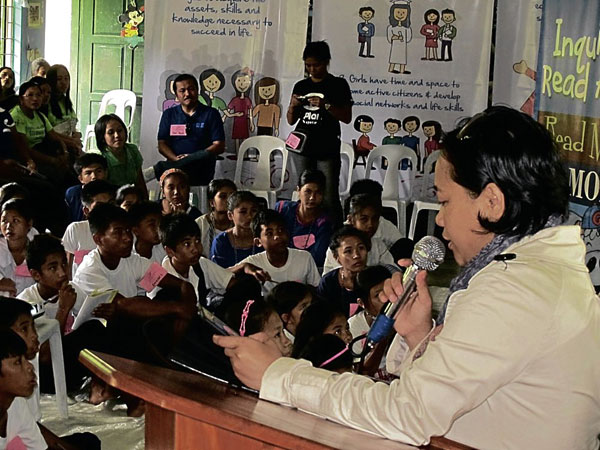Mindoro’s remote village experiences read-along for first time

IRENE Mora reads a story during the Inquirer Read-Along San Jose, Occidental Mindoro on Aug. 25. JOANNA LOS BAÑOS
It took teacher Rosita Montajes a lot of courage to use a microphone in reading a story with illustrations flashed on a big screen.
Montajes is a Mangyan of the subtribe Taubuhid.
Montajes was substituting for a storyteller, an indigenous girl initially asked to join Inquirer’s Read-Along session that morning on August 25 but the girl could not make it because she was unable to cross the two rivers from her house in Sitio Naibuan.
“We are not used to this,” said Montejos, who pointed to the storytelling paraphernalia for the read-along, the first to be held in Mindoro Island since the program was launched in 2007.
Montajes, an instructional manager under the Alternative Learning System of the Department of Education, said the Mangyan used to write and read their ancient surat Mangyan (script) on the bark of trees.
Article continues after this advertisementEven as the Mangyan people, who comprise around 10 percent of the island’s population, are the original dwellers of Mindoro, many of them lack access to education, making them victims of land grabbing and prey to “cheating” in trade dealings with lowlanders.
Article continues after this advertisementMontajes said that with improved reading and comprehension skills, the Mangyan would “survive” the literate world where many of them, particularly the elderly, get lost.
“There are instances when some of them could not commute because they could not read the signage,” she said.
The nongovernment Plan International brought the read-along to the farming village of Batasan, located 22 kilometers away from the poblacion of this town which is some 250 kilometers south of Manila.
Two classrooms were merged to accommodate more than 50 participants, teachers and village officials at the Central National High School-Batasan Extension, where Mangyan and Tagalog students sat together at the cemented floor covered with a long piece of cloth.
“We want them to learn together,” said Joan Gonzales, community development facilitator for Plan International.
Notwithstanding the noise of a generator set up due to a power failure, the participants did not seem distracted. A prayer ritual dance accompanied by sounds from wooden sticks held by Mangyan students opened the event.
From among 44 participants, 22 were Mangyan students.
The first story read, “Bagaw Ginan sa Banag” (Voice from the Ibanaag), was chosen to commemorate August as Indigenous Peoples Month and also to focus on the importance of August as national language month.
The story is part of a book of stories told by Higod Ligom, Yango Panugao, Oming Fortunato and Lina Mendez who belong to the Mangyan Hanunuo subtribe. It was illustrated by Katherine Fell and published by Plan International and the Australian government.
In the early days, one starry night, a girl named Berjen asked the elderly why their place came to be known as Banag, the first story goes. One version said their place was named after a local hero named Banag who protected the villagers from the attack of a vicious forest dog.
After reading the story, Montajes asked the participants what could be the origin of their village. Several stories were shared by participants until village councilor Fe Francisco explained that their place used to be inhabited mostly by the Mangyan under the leadership of a man named Bantas but migrants later drove them to the mountains.
The second story, “Si Diwayen, Noong Bago Dumating Ang Mga Espanyol” (Diwayen Before the Spaniards Came), written by Augie Rivera, illustrated by Paolo Lim, and published by the United Nations Children’s Fund and Adarna House, was read by pilot Irene Mora, also a hotel owner in San Jose town.
Mora narrated the travails of a poor girl, Diwayen, 9, who was “pawned” as a slave of Datu Bulawen and tasked to do household chores for him.
One day, the Datu’s daughter Princess Lunhaw insisted on playing in the forest but a wild boar cornered her. Diwayen came to her rescue by stabbing the boar dead with a sharp branch. Diwayen regained her freedom after that.
The story of the princess and the slave girl conformed with Plan International’s campaign to promote the rights of girls.
Mora stressed that “reading is critical to having the education that could bring them to a brighter future.” A mother of three adopted children, she enjoined the students to keep on dreaming and to work for it.
Educator Adrian Anthony Osano said the read-along awakened the interest for reading among the students.